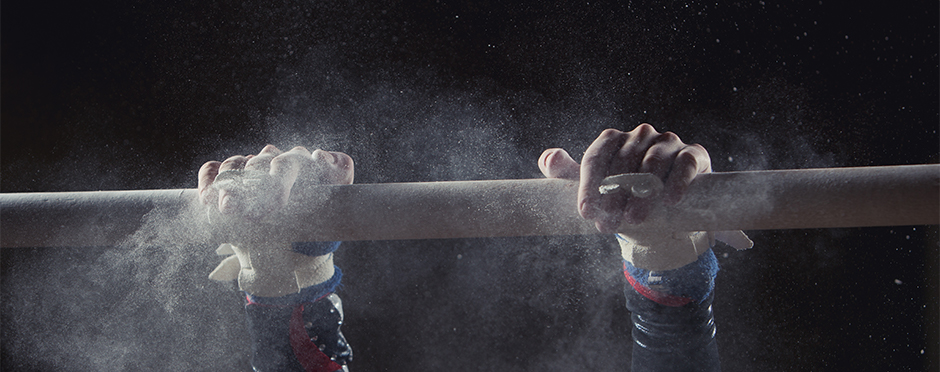
Gymnast Wrist: Risk Factors, Symptoms and Treatment Options
4 CommentsGymnastics is a unique sport in that the athletes spend a large amount of time on their hands. Handstands, tumbling and bars all require the athlete to place their full body weight through the arms and onto the hands. A unique injury to gymnastics is Gymnast Wrist.
What is Gymnast Wrist?
Gymnast wrist is used to describe a variety of overuse injuries that can occur in adolescent gymnasts. It is a combination of injuries to the bone and the ligaments of the wrist. Gymnast wrist occurs as a result of the repetitive compressive forces applied across the wrist during the weight bearing activities of gymnastics. Gymnast wrist is commonly shown as a chronic stress fracture of the distal radius, and in these skeletally immature gymnasts, this is near the growth plate of the wrist.
Risk Factors for Gymnast Wrist:
- Improper equipment
- Incorrect technique
- Previous injury
- Delayed skeletal maturity
- Growth spurts
- Recent increase in training intensity
- Large numbers of impact (tumbling and vaulting) repetitions
Gymnastic Events with Increased Stress on the Wrist:
- Floor routine
- Vault
- Balance Beam
- Pommel Horse
During these activities, the wrist can be subjected to forces up to 16 times the athlete’s body weight.1
Symptoms of Gymnast Wrist
- Pain with gradual onset
- Aggravation of pain with weight bearing activities when the wrist in an extended position
- Swelling over the wrist
- Tenderness over the wrist
- Possible pain with wrist extension motion
- Decreased grip strength
Treatment and Prevention of Gymnast Wrist
Treatment for Gymnast wrist typically requires activity modification, specifically stopping all weight bearing activity on the hands. Many times young gymnasts will be placed in a splint or brace to remind them not to perform tumbling skills. Ice and anti-inflammatory medications can also be used to address the swelling and pain at the wrist.
It is also important to note that physical therapy can assist in returning the gymnast to their sport. Physical therapy will focus on strengthening the wrist, forearm and upper body. Gymnasts will not return to tumbling until they are pain free.
There are also surgical options available if conservative management is unable to relieve the pain in the wrist. However, there is a high chance of pain returning with the continuation of competitive gymnastic activities.
Examples of How to Strengthen the Wrist, Forearm and Upper Body:
- Wrist curls in both directions with a weight or resistance band
- Gripping exercises for the hands
- Wrist rotation exercises, such as hand weight rolling
- Supination/Pronation with a hand weight
- Resistance band exercises including rows, shoulder extension, diagonals and internal/external rotation
- Tricep extension with band or hand weight
- Bicep curls with band or hand weight
- Gradual return to weight-bearing exercises, including push-ups, planks and handstands once the athlete is pain free in the wrist
- Any hanging exercise (bars) is also only performed when the wrist is pain free, including pull ups, hanging leg lifts and casting
If you are a gymnast with wrist pain, contact a nearby Athletico clinic for a free assessment so you can discuss treatment options with one of our experts.
The Athletico blog is an educational resource written by Athletico employees. Athletico bloggers are licensed professionals who abide by the code of ethics outlined by their respective professional associations. The content published in blog posts represents the opinion of the individual author based on their expertise and experience. The content provided in this blog is for informational purposes only, does not constitute medical advice and should not be relied on for making personal health decisions.
References:
1. Webb BG, Rettig LA (2008) Gymnastic wrist injuries. Curr Sports Med Rep 7:289–295
2. Dwek, Jerry R et al. “MR imaging of overuse injuries in the skeletally immature gymnast: spectrum of soft-tissue and osseous lesions in the hand and wrist” Pediatric radiology vol. 39,12 (2009): 1310-6.

4 Comments
Nani Lehua
What are some of the surgical options to cure gymnast wrist? What would they be like and how long would it take estimated?
Athletico
Thanks for reaching out Nani! Please call 877-ATHLETICO for specific questions about injuries.
Kim Ekhoff
My daughter was a competitive gymnast, but has been “retired” for 3 years with no tumbling. She tumbled after a 3 year break and immediately had radiating pain in both wrists. Can Gymnast Wrist sill be active after that long of a break?
Tara Hackney, PT, DPT, OCS, KTTP
Thank you for reaching out Kim. Generally, gymnast wrist is an overuse injury so after a 3 year break it may not be exactly the cause of her pain. If you want to find your closest Athletico clinic and schedule an injury assessment they may be better able to discuss your daughter’s condition.